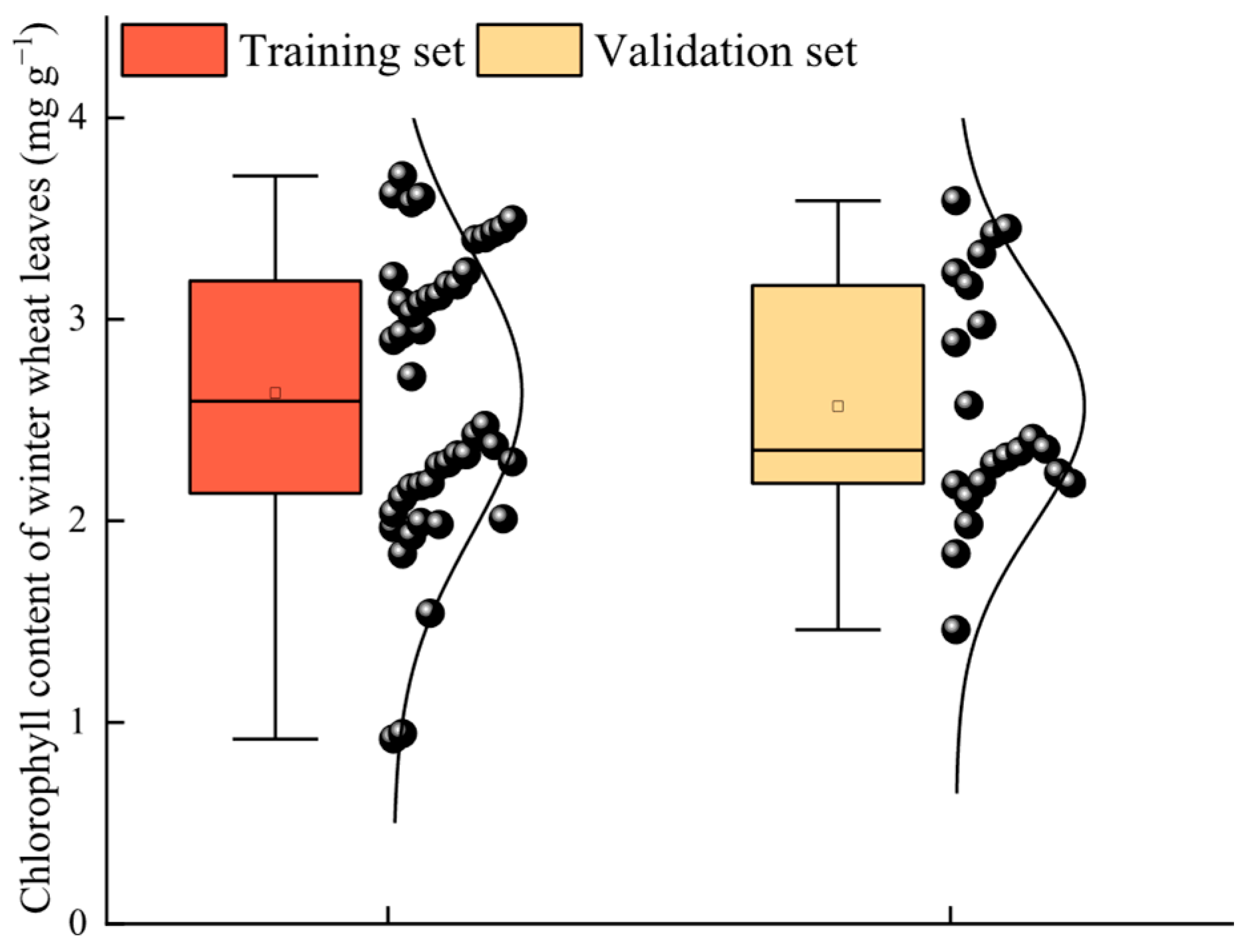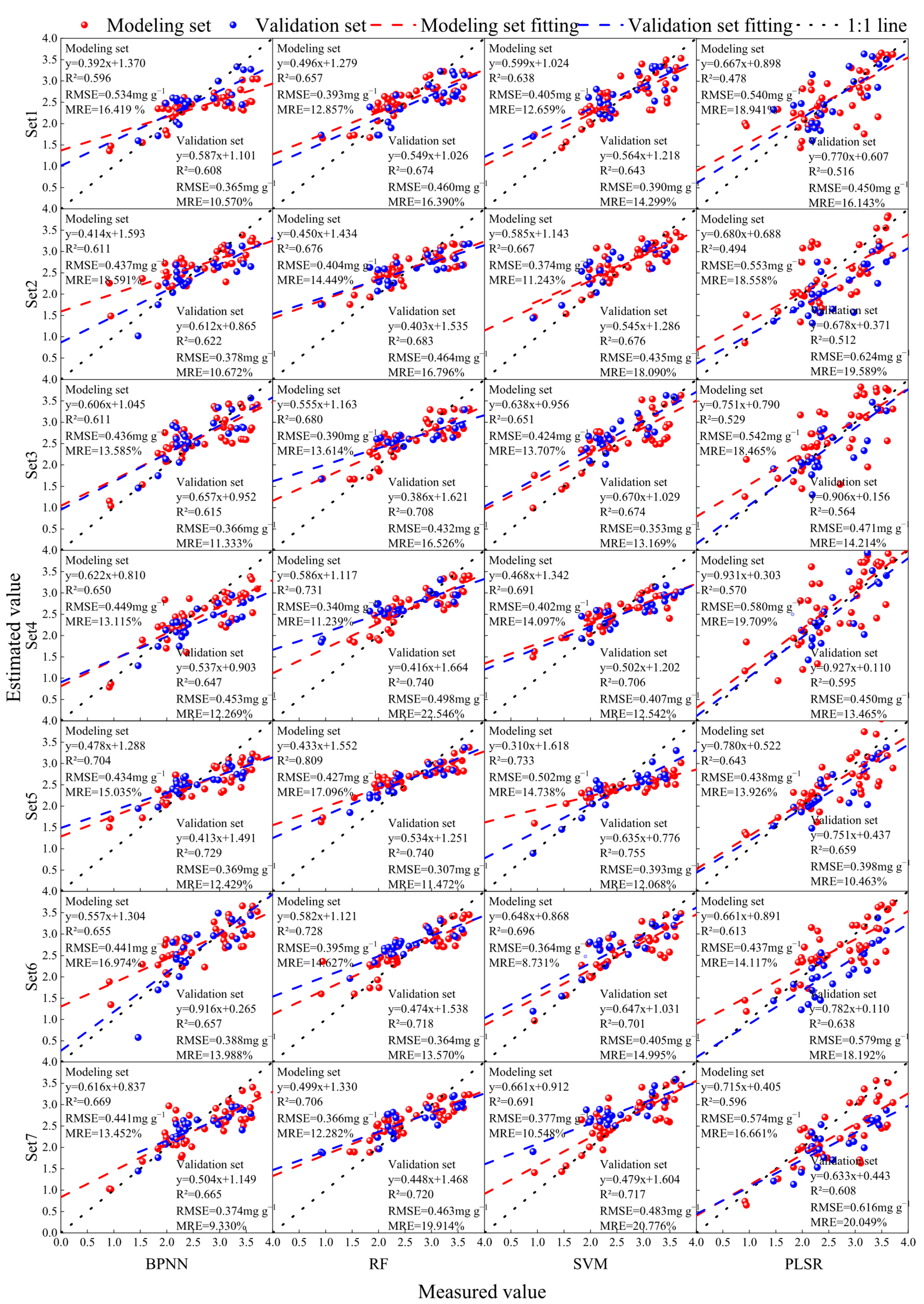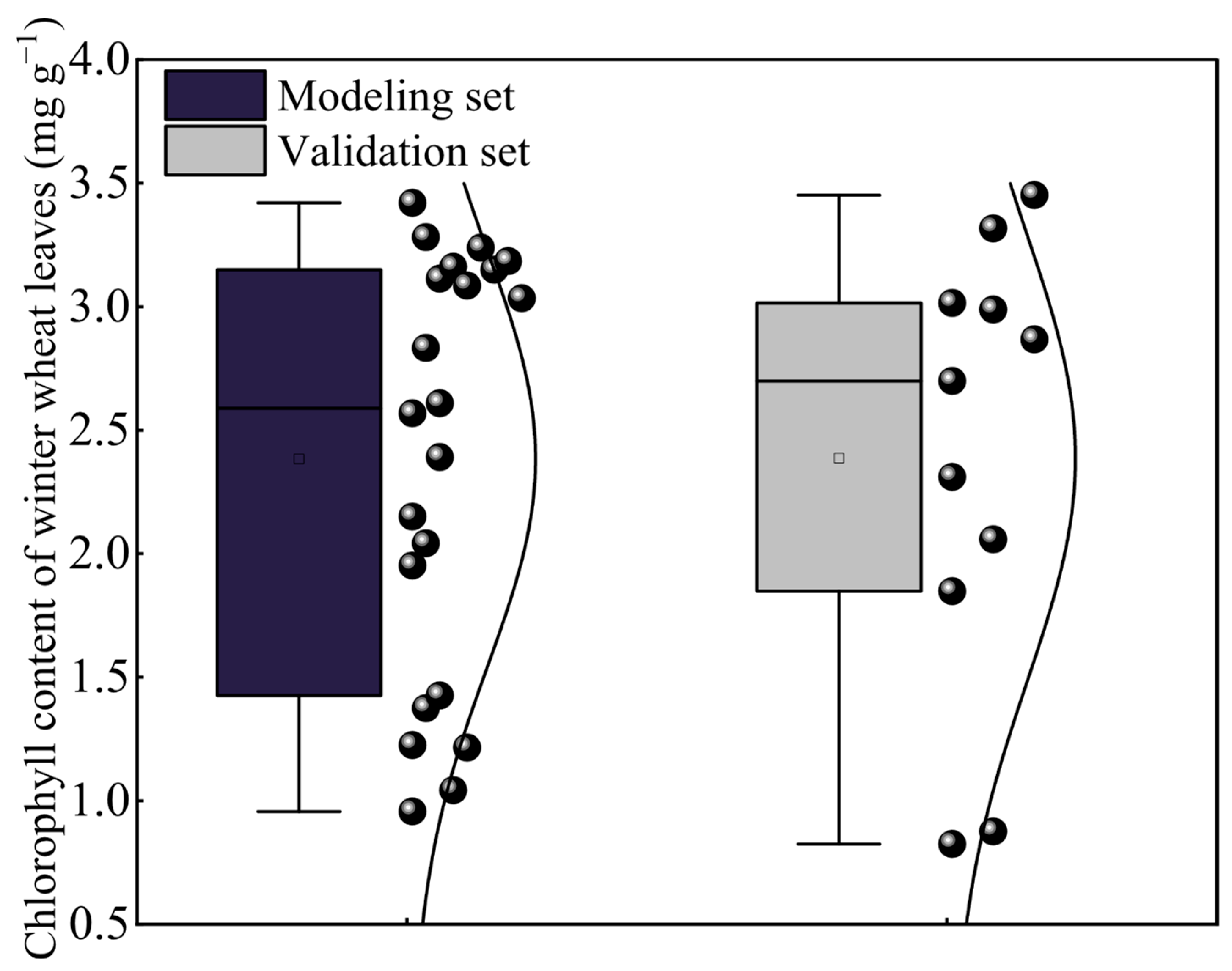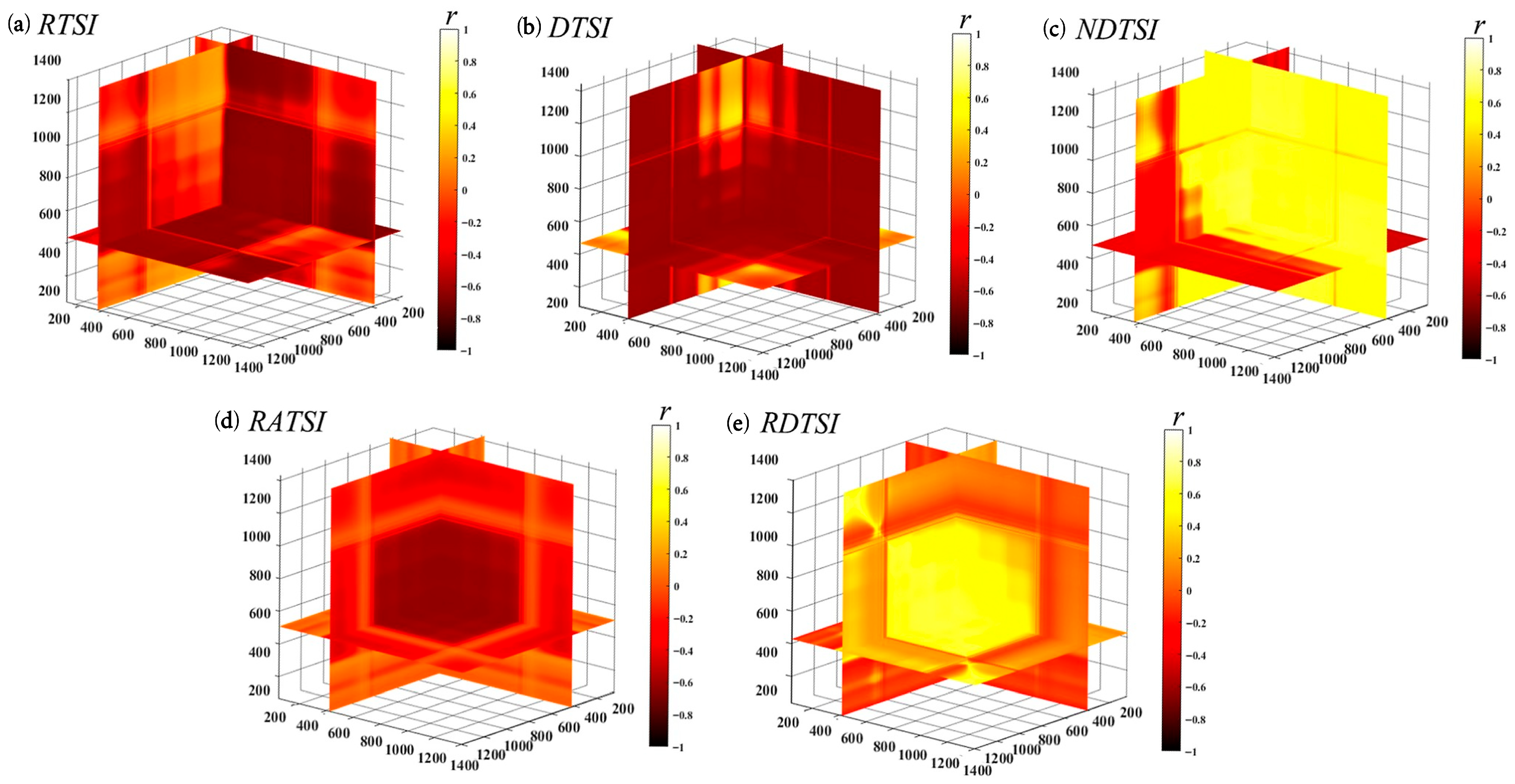Three-Dimensional Spectral Index-Driven Nondestructive Quantification of Chlorophyll in Winter Wheat: Cross-Phenology Extrapolation and Independent Validation
Abstract
1. Introduction
2. Materials and Methods
2.1. Study Area and Experimental Design
2.2. Data Acquisition and Preprocessing
2.2.1. Spectral Data Acquisition
2.2.2. Chlorophyll Determination
2.2.3. Conversion and Optimization of Spectral Data
2.3. Selection and Construction of Spectral Indices
2.4. Modeling Methods
2.5. Description of Sample Size and Model Building Process
3. Results
3.1. Correlation Between Spectral Indices and Winter Wheat Chlorophyll Content
3.2. Correlation Between Optimal Spectral Indices and Winter Wheat Chlorophyll Content
3.3. Construction of Chlorophyll Estimation Models for Winter Wheat
3.4. External Validation and Model Evaluation for Winter Wheat Chlorophyll Content
4. Discussion
5. Conclusions
Author Contributions
Funding
Data Availability Statement
Conflicts of Interest
References
- Adil, M.; Wang, Z.C.; Chen, Y.; Lu, H.; Lu, S.Q.; Bashir, S.; Gul, I.; Li, H.; Han, Z.R.; Feng, W.F. Long-term impacts of agronomic practices on winter wheat yield, water use efficiency, and nitrogen use efficiency in global dryland regions: A meta-analysis. Soil Tillage Res. 2025, 253, 106653. [Google Scholar] [CrossRef]
- Yang, J.; Zhang, S.J.; Zhang, J.H.; Zhao, S.; Lu, H.T.; Li, L.W.; Liu, L.T.; Wang, G.Y. Incorporating crop rotation into the winter wheat–summer maize system to enhance soil multifunctionality and sustainable grain production in the North China Plain. Field Crops Res. 2025, 325, 109834. [Google Scholar] [CrossRef]
- Li, R.; Chen, Y.Z.; Chai, Y.W.; Li, Y.W.; Ma, J.T.; Cheng, H.B.; Chang, L.; Chai, S.X. Optimizing straw strip-mulching to enhance winter wheat productivity in semi-arid drylands. Field Crops Res. 2025, 329, 109957. [Google Scholar] [CrossRef]
- Tang, Z.J.; Lu, J.S.; Xiang, Y.Z.; Shi, H.Z.; Sun, T.; Zhang, W.; Wang, H.; Zhang, X.Y.; Li, Z.J.; Zhang, F.C. Farmland mulching and optimized irrigation increase water productivity and seed yield by regulating functional parameters of soybean (Glycine max L.) leaves. Agric. Water Manag. 2024, 298, 108875. [Google Scholar] [CrossRef]
- Tang, Z.J.; Wang, X.; Xiang, Y.Z.; Liang, J.P.; Guo, J.J.; Li, W.Y.; Lu, J.S.; Du, R.Q.; Li, Z.J.; Zhang, F.C. Application of hyperspectral technology for leaf function monitoring and nitrogen nutrient diagnosis in soybean (Glycine max L.) production systems on the Loess Plateau of China. Eur. J. Agron. 2024, 154, 127098. [Google Scholar] [CrossRef]
- Shi, H.Z.; Guo, J.; An, J.Q.; Tang, Z.J.; Wang, X.; Li, W.Y.; Zhao, X.; Jin, L.; Xiang, Y.Z.; Li, Z.J.; et al. Estimation of chlorophyll content in soybean crop at different growth stages based on optimal spectral index. Agronomy 2023, 13, 663. [Google Scholar] [CrossRef]
- Zhang, N.; Pan, Y.; Feng, H.; Zhao, X.; Yang, X.; Ding, C.; Yang, G. Development of fusarium head blight classification index using hyperspectral microscopy images of winter wheat spikelets. Biosyst. Eng. 2019, 186, 83–99. [Google Scholar] [CrossRef]
- Filchev, L.; Pashova, L.; Kolev, V.; Frye, S. Surveys, Catalogues, Databases/Archives, and State-of-the-Art Methods for Geoscience Data Processing. In Knowledge Discovery in Big Data from Astronomy and Earth Observation; Elsevier: Amsterdam, The Netherlands, 2020. [Google Scholar] [CrossRef]
- Small, C.; Okujeni, A.; van der Linden, S.; Waske, B. 6.08-remote sensing of urban environments. In Comprehensive Remote Sensing, 2nd ed.; Liang, S., Ed.; Elsevier: Oxford, UK, 2026; pp. 117–148. ISBN 978-0-443-23949-6. [Google Scholar]
- Montanaro, G.; Carlomagno, A.; Giorio, P.; Petrozza, A.; Cellini, F.; Nuzzo, V. Are leaf chlorophyll fluorescence and dark green stressor-specific fingerprints in grapevine under drought or salt stress? A reanalysis study. Plant Stress 2025, 17, 100948. [Google Scholar] [CrossRef]
- Peng, S.; Bao, N.; Gu, N.; Qian, H.; Han, Z.; Zhou, B.; Chang, L. Enhanced assessment of chlorophyll-a and total nitrogen dynamics using unmanned aerial vehicle-based model and hyperspectral imagery in coastal wetland water. Environ. Technol. Innov. 2025, 40, 104521. [Google Scholar] [CrossRef]
- Li, P.Y.; Poblete, T.; Hornero, A.; Aryal, G.; Zarco-Tejada, P.J. Distinct contribution of the blue spectral region and far-red solar-induced fluorescence to needle nitrogen and phosphorus assessment in coniferous nutrient trials with hyperspectral imagery. Remote Sens. Environ. 2025, 328, 114915. [Google Scholar] [CrossRef]
- Niu, T.; Hou, Z.Z.; Yu, J.X.; Lu, J.; Yu, Q.; Yang, L.Z.; Ma, J.; Liu, Y.F.; Shi, H.; Jin, X.Y. Construction of prediction model for water retention of forest ecosystem in alpine region based on vegetation spectral features. Ecol. Indic. 2024, 169, 112889. [Google Scholar] [CrossRef]
- Zhang, J.; Zhang, D.F.; Cai, Z.J.; Wang, L.B.; Wang, J.; Sun, L.; Fan, X.F.; Shen, S.X.; Zhao, J.J. Spectral technology and multispectral imaging for estimating the photosynthetic pigments and SPAD of the Chinese cabbage based on machine learning. Comput. Electron. Agr. 2022, 195, 106814. [Google Scholar] [CrossRef]
- Li, Y.; Zhao, B.; Zhou, L.; Wei, L.G.; Dong, X.; Yuan, Y.W. Estimation of SPAD value of winter wheat at jointing stage based on multi-type parameters. Trans. Chin. Soc. Agric. Mach. 2025, 56, 513–521. (In Chinese) [Google Scholar]
- Cui, B.; Zhao, Q.J.; Huang, W.J.; Song, X.Y.; Ye, H.C.; Zhou, X.F. A new integrated vegetation index for the estimation of winter wheat leaf chlorophyll content. Remote Sens. 2019, 11, 974. [Google Scholar] [CrossRef]
- Liu, S.; Yu, H.Y.; Zhang, J.H.; Zhou, H.G.; Kong, L.J.; Zhang, L.; Dang, J.M.; Sui, Y.Y. Study on inversion model of chlorophyll content in soybean leaf based on optimal spectral indices. Spectrosc. Spectr. Anal. 2021, 41, 1912–1919. (In Chinese) [Google Scholar] [CrossRef]
- Tang, Z.J.; Xiang, Y.Z.; Wang, X.; Zhang, W.; Li, Z.J.; Zhang, F.C.; Chen, J.Y. Nitrogen nutrition diagnosis of winter oilseed rape using spectral indexes optimized by correlation matrix method. Trans. Chin. Soc. Agric. Eng. 2023, 39, 97–106. (In Chinese) [Google Scholar]
- Zhang, W.; Li, Z.J.; Pu, Y.; Zhang, Y.T.; Tamh, Z.J.; Fu, J.Y.; Xu, W.J.; Xiang, Y.Z.; Zhang, F.C. Estimation of the leaf area index of winter rapeseed based on hyperspectral and machine learning. Sustainability 2023, 15, 12930. [Google Scholar] [CrossRef]
- Zhou, J.; Li, F.; Wang, X.; Yin, H.; Zhang, W.; Du, J.; Pu, H. Hyperspectral and fluorescence imaging approaches for nondestructive detection of rice chlorophyll. Plants 2024, 13, 1270. [Google Scholar] [CrossRef]
- Xiang, Y.Z.; Wang, X.; An, J.Q.; Tang, Z.J.; Li, W.Y.; Shi, H.Z. Estimation of leaf area index of soybean based on fractional-order differentiation and optimal spectral index. Trans. Chin. Soc. Agric. Mach. 2023, 54, 329–342. (In Chinese) [Google Scholar]
- Geng, J.; Lv, J.W.; Pei, J.; Liao, C.H.; Tan, Q.Y.; Wang, T.X.; Fang, H.J.; Wang, L. Prediction of soil organic carbon in black soil based on a synergistic scheme from hyperspectral data: Combining fractional-order derivatives and three-dimensional spectral indices. Comput. Electron. Agr. 2024, 220, 108905. [Google Scholar] [CrossRef]
- Tang, Z.J.; Guo, J.J.; Xiang, Y.Z.; Lu, X.H.; Wang, Q.; Wang, H.D.; Cheng, M.H.; Wang, H.; Wang, X.; An, J.Q. Estimation of leaf area index and above-ground biomass of winter wheat based on optimal spectral index. Agronomy 2022, 12, 1729. [Google Scholar] [CrossRef]
- Cui, S.; Li, Z.; Tang, Z.; Zhang, W.; Sun, T.; Wu, Y.; Yang, W.; Chen, G.; Xiang, Y.; Zhang, F. Estimation of nitrogen concentration in winter wheat leaves based on a novel spectral index and machine learning model. Plants 2025, 14, 2772. [Google Scholar] [CrossRef] [PubMed]
- Wang, X.; Li, W.Y.; An, J.Q.; Shi, H.Z.; Tang, Z.J.; Guo, J.J.; Jin, L.; Xiang, Y.Z.; Li, Z.J.; Zhang, F.C. Effects of nitrogen supply on dry matter accumulation, water–nitrogen use efficiency and grain yield of soybean (Glycine max L.) under different mulching methods. Agronomy 2023, 13, 606. [Google Scholar] [CrossRef]
- Guo, J. Effects of Water and Nitrogen Regulation and Slow-Release Nitrogen Fertilizer Combined with Urea on Growth, Water and Nitrogen Utilization of Winter Wheat/Summer Maize. Ph.D. Thesis, Northwest A&F University, Yangling, China, 2022. (In Chinese). [Google Scholar]
- Bouslihim, Y.; Bouasria, A.; Minasny, B.; Castaldi, F.; Nenkam, A.M.; El Battay, A.; Chehbouni, A. Soil organic carbon prediction and mapping in morocco using PRISMA hyperspectral imagery and meta-learner model. Remote Sens. 2025, 17, 1363. [Google Scholar] [CrossRef]
- Laamrani, A.; Berg, A.A.; Voroney, P.; Feilhauer, H.; Blackburn, L.; March, M.; Dao, P.D.; He, Y.; Martin, R.C. Ensemble identification of spectral bands related to soil organic carbon levels over an agricultural field in southern Ontario, Canada. Remote Sens. 2019, 11, 1298. [Google Scholar] [CrossRef]
- Ma, P.; Zhuo, Y.; Chen, G.; Burken, J.G. Natural gas induced vegetation stress identification and discrimination from hyperspectral imaging for pipeline leakage detection. Remote Sens. 2024, 16, 1029. [Google Scholar] [CrossRef]
- Main, R.; Cho, M.A.; Mathieu, R.; O’Kennedy, M.M.; Ramoelo, A.; Koch, S. An investigation into robust spectral indices for leaf chlorophyll estimation. ISPRS J. Photogramm. Remote Sens. 2011, 66, 751–761. [Google Scholar] [CrossRef]
- Huete, A.R.; Liu, H.Q.; Batchily, K.; van Leeuwen, W. A comparison of vegetation indices over a global set of TM images for EOS-MODIS. Remote Sens. Environ. 1997, 59, 440–451. [Google Scholar] [CrossRef]
- Le Maire, G.; François, C.; Soudani, K.; Berveiller, D.; Pontailler, J.Y.; Bréda, N.; Genet, H.; Davi, H.; Dufrěne, E. Calibration and validation of hyperspectral indices for the estimation of broadleaved forest leaf chlorophyll content, leaf mass per area, leaf area index and leaf canopy biomass. Remote Sens. Environ. 2008, 112, 3846–3864. [Google Scholar] [CrossRef]
- Haboudane, D.; Miller, J.R.; Pattey, E.; Zarco-Tejada, P.J.; Strachan, I.B. Hyperspectral vegetation indices and novel algorithms for predicting green LAI of crop canopies: Modeling and validation in the context of precision agriculture. Remote Sens. Environ. 2004, 90, 337–352. [Google Scholar] [CrossRef]
- Hunt, E.R., Jr.; Daughtry, C.S.T.; Eitel, J.U.H.; Long, D.S. Remote Sensing Leaf Chlorophyll Content Using a Visible Band Index. Agron. J. 2011, 103, 1090–1099. [Google Scholar] [CrossRef]
- Apan, A.; Held, A.; Phinn, S.; Markley, J. Formulation and assessment of narrow-band vegetation indices from EO-1 Hyperion imagery for discriminating sugarcane disease. In Proceedings of the Spatial Sciences Conference 2003, Canberra, Australia, 17–23 September 2003. [Google Scholar]
- Zhang, D.; Zhao, Y.; Qin, K.; Zhao, N.B.; Yang, Y.C. Influence of spectral transformation methods on nutrient content inversion accuracy by hyperspectral remote sensing in black soil. Trans. Chin. Soc. Agric. Eng. 2018, 34, 141–147. (In Chinese) [Google Scholar] [CrossRef]
- Lu, X.H.; Gong, R.; Zhang, H.; Wang, Q.; Zhang, J.; Xie, R.X. Estimation of Photosynthetic Parameters of Cinnamomum camphora in Dwarf Forest Based on UAV Multi-spectral Remote Sensing. Trans. Chin. Soc. Agric. Mach. 2023, 54, 179–187. (In Chinese) [Google Scholar]
- Murai, T.; Tobari, T.; Kudo, S.; Saito, Y. Time-series characterization of various honey types under different storage conditions based on total polyphenol content and fluorescence properties. Appl. Food Res. 2025, 5, 101150. [Google Scholar] [CrossRef]
- Tang, Z.J.; Cai, Y.; Xiang, Y.; Lu, J.S.; Sun, T.; Shi, H.Z.; Liu, X.C.; Zhang, X.Y.; Li, Z.J.; Zhang, F.C. Nitrogen nutritional diagnosis of summer maize (Zea mays L.) based on a hyperspectral data collaborative approach—Evaluation of the estimation potential of three-dimensional spectral indices. Comput. Electron. Agric. 2025, 229, 109713. [Google Scholar] [CrossRef]
- Tang, Z.J.; Zhang, W.; Xiang, Y.; Li, Z.J.; Zhang, F.C.; Chen, J.Y. Monitoring of Soil Moisture Content of Winter Wheat Based on Hyperspectral and Machine Learning Models. Trans. Chin. Soc. Agric. Mach. 2023, 54, 350–358. (In Chinese) [Google Scholar]
- Liu, X.C.; Li, Z.J.; Xiang, Y.Z.; Tang, Z.J. Estimation of Winter Wheat Chlorophyll Content Based on Wavelet Transform and the Optimal Spectral Index. Agronomy 2024, 14, 1309. [Google Scholar] [CrossRef]
- Xu, H.F.; Yu, C.; Bai, Y.; Zuo, A.W.; Ye, Y.T.; Liu, Y.R.; Li, Z.K.; Dai, G.Z.; Chen, M.; Qiu, B.S. Red-light-dependent chlorophyll synthesis kindles photosynthetic recovery of chlorotic dormant cyanobacteria using a dark-operative enzyme. Curr. Biol. 2024, 34, 4424–4435.e3. [Google Scholar] [CrossRef]
- Hassan, M.A.; Chang, C.Y. PhenoGazer: A high-throughput phenotyping system to track plant stress responses using hyperspectral reflectance, nighttime chlorophyll fluorescence and RGB imaging in controlled environments. Plant Phenomics 2025, 7, 100047. [Google Scholar] [CrossRef]
- Poblete, T.; Watt, M.S.; Buddenbaum, H.; Zarco-Tejada, P.J. Chlorophyll content estimation in radiata pine using hyperspectral imagery: A comparison between empirical models, scaling-up algorithms, and radiative transfer inversions. Agric. For. Meteorol. 2025, 362, 110402. [Google Scholar] [CrossRef]
- Yao, H.X.; Li, J.S.; Zhou, Y.M.; Liu, Y.; Jiang, D.L.; Yin, S.J.; Jiang, X.Z.; Zhang, F.F.; Wang, S.L.; Zhang, B. A novel hyperspectral index for quantifying chlorophyll-a concentration in productive waters. Remote Sens. Environ. 2025, 328, 114847. [Google Scholar] [CrossRef]
- Gao, D.; Qiao, L.; Song, D.; Li, M.Z.; Sun, H.; An, L.L.; Zhao, R.M.; Tang, W.J.; Qiao, J.B. In-field chlorophyll estimation based on hyperspectral images segmentation and pixel-wise spectra clustering of wheat canopy. Biosyst. Eng. 2022, 217, 41–55. [Google Scholar] [CrossRef]
- Corrado, F.; Putzolu, F.; Armstrong, R.N.; Mondillo, M.; Chirico, R.; Massironi, M.; Fuller, D.; Ball, R.; Herrington, R.J. Application of satellite and proximal hyperspectral sensing to target lithium mineralization in volcano-sedimentary deposits: A case study from the McDermitt caldera, USA. Remote Sens. Environ. 2025, 323, 114724. [Google Scholar] [CrossRef]
- Prabhakar, M.; Padmavathi, C.; Thirupathi, M.; Golla, S.K.; Sravan, U.S.; Rao, G.R.; Kalpana, M.; Sailaja, V.; Chandana, P.; Prasad, Y. Remote sensing of rice leaf folder damage using ground-based hyperspectral radiometry. Smart Agric. Technol. 2025, 10, 100757. [Google Scholar] [CrossRef]
- Abukassem, I.; Bero, M.A. Spectral response of radiochromic gel detector in the near-ultraviolet region (200–400 nm). Radiat. Meas. 2016, 87, 43–48. [Google Scholar] [CrossRef]
- Gitelson, A.A.; Merzlyak, M.N.; Lichtenthaler, H.K. Detection of red edge position and chlorophyll content by reflectance measurements near 700 nm. J. Plant Physiol. 1996, 148, 501–508. [Google Scholar] [CrossRef]
- Hu, S.; Bao, Y.; Tubuxinbayaer; Tao, J.F.; Guo, E.L. Chlorophyll Content Inversion of Spring Wheat Based on Unmanned Aerial Vehicle Hyperspectral and Integrated Learning. J. Agric. Sci. Technol. 2025, 27, 93–103. (In Chinese) [Google Scholar] [CrossRef]
- Zahir, S.A.D.M.; Jamlos, M.F.; Omar, A.F.; Nordin, M.A.H.; Raypah, M.E.A.; Mamat, R.B.; Jamlos, M.A.; Muncan, J. Quantifying the impact of varied NPK fertilizer levels on oil palm plants during the nursery stage: A Vis–NIR spectral reflectance analysis. Smart Agric. Technol. 2025, 11, 100864. [Google Scholar] [CrossRef]
- Fu, X.; Luo, Z.; Yang, Y.; Zheng, Z.Q. Research on word memory retrieval difficulty prediction based on DBSCAN and random forest. Mod. Electron. Tech. 2023, 46, 105–110. (In Chinese) [Google Scholar]
- Zhao, Z.; Feng, Z.; Wang, Y.; Shao, Y.F.; Ren, J.J. Non-intrusive industrial load identification and robustness research based on wavelet transform random forests. Water Resour. Hydropower Eng. 2022, 53, 265–270. (In Chinese) [Google Scholar]
- Yi, H.; Niu, Z.; Li, X.; Li, B.; Jing, R. Robust recommendation algorithm combining random forest and target item identification. J. Shandong Univ. (Nat. Sci.) 2022, 57, 46–56. (In Chinese) [Google Scholar]
- Tang, Z.; Lu, J.; Sun, T.; Xiang, Y.Z.; Zhang, X.Y.; Li, Z.J.; Zhang, F.C. Nitrogen nutritional diagnosis of winter oilseed rape (Brassica napus L.) using fractional-order derivative hyperspectral indices: Field evaluation of dual nitrogen nutritional indices. Ind. Crops Prod. 2025, 235, 121660. [Google Scholar] [CrossRef]
- Feng, Y.; Wang, J.; Tang, Y. Estimation and inversion of soil heavy metal arsenic (as) based on UAV hyperspectral platform. Microchem J. 2024, 207, 112027. [Google Scholar] [CrossRef]
- Eshkabilov, S.; Lee, A.; Sun, X.; Lee, C.W.; Simsek, H. Hyperspectral imaging techniques for rapid detection of nutrient content of hydroponically grown lettuce cultivars. Comput. Electron. Agric. 2021, 181, 105968. [Google Scholar] [CrossRef]
- Cai, C.; Zhao, H.; Zhang, H.; Wang, C.; Wang, Z.; Liu, M.; Chen, J.; Zhang, H. Timely assessment of maize lodging severity with limited samples using multi-temporal sentinel-1 and sentinel-2 data across large spatial extents. Comput. Electron. Agric. 2025, 237, 110671. [Google Scholar] [CrossRef]
- Chen, C.; Zhang, C.; Zhao, L.; Yang, C.; Yao, X.; Fu, B. Soybean cultivation and crop rotation monitoring based on multi-source remote sensing data and bi-LSTM enhanced model. Comput. Electron. Agric. 2025, 239, 110959. [Google Scholar] [CrossRef]
- Bai, J.; Chen, W.; Yu, X. Real-time lithology identification based on dynamic felling strategy and differential evolutionary random forest algorithm. Geoenergy Sci. Eng. 2026, 256, 214172. [Google Scholar] [CrossRef]
- Hong, S.M.; Yoon, I.; Cho, K.H. Predicting the distribution coefficient of cesium in solid phase groups using machine learning. Chemosphere 2024, 352, 141462. [Google Scholar] [CrossRef]
- Qiu, T.; Song, C.H.; Clark, J.S.; Seyednasrollah, B.; Rathnayaka, N.; Li, J.X. Understanding the continuous phenological development at daily time step with a Bayesian hierarchical space-time model: Impacts of climate change and extreme weather events. Remote Sens. Environ. 2020, 247, 111956. [Google Scholar] [CrossRef]
- Li, L.; Wang, M.; Jiang, X.; Lin, Y. Universal multi-factor feature selection method for radiomics-based brain tumor classification. Comput. Biol. Med. 2023, 164, 107122. [Google Scholar] [CrossRef]
- Zhou, Y.; Marathe, S.; Zeman, M.; Isabella, O.; Ziar, H. Assessing the dual radiative consequences of urban PV integration: Albedo change and radiative forcing dynamics. Appl. Energy 2025, 401, 126544. [Google Scholar] [CrossRef]
- Sun, J.; Shi, S.; Yang, J.; Gong, W.; Qiu, F.; Wang, L.; Du, L.; Chen, B. Wavelength selection of the multispectral lidar system for estimating leaf chlorophyll and water contents through the PROSPECT model. Agric. For. Meteorol. 2019, 266–267, 43–52. [Google Scholar] [CrossRef]
- Li, D.; Wu, Y.; Berger, K.; Kuang, Q.; Feng, W.; Chen, J.M.; Wang, W.; Zheng, H.; Yao, X.; Zhu, Y. Estimating canopy nitrogen content by coupling PROSAIL-PRO with a nitrogen allocation model. Int. J. Appl. Earth Obs. Geoinf. 2024, 135, 104280. [Google Scholar] [CrossRef]







| Spectral Index | Formula | References |
|---|---|---|
| DDI | [30] | |
| MNDVI | [31] | |
| NDDI | [32] | |
| RDVI | [33] | |
| CI | [30] | |
| MTCI | [34] | |
| Gitelson2 | [35] |
| Empirical Spectral Index | Correlation |
|---|---|
| DDI | 0.574 * |
| MNDVI | 0.464 * |
| NDDI | 0.637 * |
| RDVI | 0.561 * |
| CI | 0.320 * |
| MTCI | 0.459 * |
| Gitelson2 | 0.238 |
| Optimal Spectral Index | Correlation | Position of Wavelength (i, j)/(nm) |
|---|---|---|
| SAVI | 0.619 * | (720, 536) |
| NDVI | 0.585 * | (1207, 1304) |
| TVI | 0.699 * | (360, 747) |
| mSR | 0.585 * | (1304, 1206) |
| mNDI | 0.585 * | (1304, 1206) |
| RI | 0.585 * | (1304, 1207) |
| DI | 0.686 * | (360, 742) |
| RTSI | 0.682 * | (1207, 750, 1318) |
| DTSI | 0.703 * | (680, 807, 1822) |
| NDTSI | 0.644 * | (1207, 1272, 1318) |
| RDTSI | 0.697 * | (742, 742, 747) |
| RATSI | 0.698 * | (738, 749, 881) |
| Machine Learning Model | Modeling Set R2 | Validation Set R2 | |
|---|---|---|---|
| Set 1 | BPNN | 0.60l | 0.61kl |
| RF | 0.66hijk | 0.67g | |
| SVM | 0.64k | 0.64hi | |
| PLSR | 0.48o | 0.52n | |
| Set 2 | BPNN | 0.61l | 0.62ijk |
| RF | 0.68fghi | 0.68efg | |
| SVM | 0.67ghij | 0.68fg | |
| PLSR | 0.49o | 0.51n | |
| Set 3 | BPNN | 0.61l | 0.62jkl |
| RF | 0.68efgh | 0.71cde | |
| SVM | 0.65ijk | 0.67g | |
| PLSR | 0.53n | 0.56m | |
| Set 4 | BPNN | 0.65ijk | 0.65hi |
| RF | 0.73b | 0.74ab | |
| SVM | 0.69defg | 0.71cde | |
| PLSR | 0.57m | 0.59l | |
| Set 5 | BPNN | 0.70cde | 0.73bc |
| RF | 0.81a | 0.74ab | |
| SVM | 0.73b | 0.76a | |
| PLSR | 0.64jk | 0.66gh | |
| Set 6 | BPNN | 0.66hijk | 0.66gh |
| RF | 0.73bc | 0.72bcd | |
| SVM | 0.70def | 0.70def | |
| PLSR | 0.61l | 0.64hij | |
| Set 7 | BPNN | 0.67ghij | 0.67gh |
| RF | 0.71cd | 0.72bcd | |
| SVM | 0.69defg | 0.72bcd | |
| PLSR | 0.60l | 0.61kl | |
| Significant level | |||
| Set | ** | * | |
| Machine learning model | * | * | |
| Set * Machine learning model | * | * | |
| Empirical Index | Correlation |
|---|---|
| DDI | 0.448 * |
| MNDVI | 0.359 * |
| NDDI | 0.543 * |
| RDVI | 0.350 * |
| CI | 0.184 |
| MTCI | 0.473 * |
| Gitelson2 | 0.447 * |
| Empirical Index | Correlation | Position of Wavelength (i, j)/(nm) |
|---|---|---|
| RTSI | 0.686 | (699, 716, 783) |
| DTSI | 0.640 | (719, 750, 816) |
| NDTSI | 0.642 | (758, 709, 829) |
| RDTSI | 0.651 | (749, 770, 777) |
| RATSI | 0.641 | (775, 773, 855) |
Disclaimer/Publisher’s Note: The statements, opinions and data contained in all publications are solely those of the individual author(s) and contributor(s) and not of MDPI and/or the editor(s). MDPI and/or the editor(s) disclaim responsibility for any injury to people or property resulting from any ideas, methods, instructions or products referred to in the content. |
© 2025 by the authors. Licensee MDPI, Basel, Switzerland. This article is an open access article distributed under the terms and conditions of the Creative Commons Attribution (CC BY) license (https://creativecommons.org/licenses/by/4.0/).
Share and Cite
Li, Z.; Zhang, W.; Tang, Z.; Xiang, Y.; Zhang, F. Three-Dimensional Spectral Index-Driven Nondestructive Quantification of Chlorophyll in Winter Wheat: Cross-Phenology Extrapolation and Independent Validation. Agronomy 2025, 15, 2376. https://doi.org/10.3390/agronomy15102376
Li Z, Zhang W, Tang Z, Xiang Y, Zhang F. Three-Dimensional Spectral Index-Driven Nondestructive Quantification of Chlorophyll in Winter Wheat: Cross-Phenology Extrapolation and Independent Validation. Agronomy. 2025; 15(10):2376. https://doi.org/10.3390/agronomy15102376
Chicago/Turabian StyleLi, Zhijun, Wei Zhang, Zijun Tang, Youzhen Xiang, and Fucang Zhang. 2025. "Three-Dimensional Spectral Index-Driven Nondestructive Quantification of Chlorophyll in Winter Wheat: Cross-Phenology Extrapolation and Independent Validation" Agronomy 15, no. 10: 2376. https://doi.org/10.3390/agronomy15102376
APA StyleLi, Z., Zhang, W., Tang, Z., Xiang, Y., & Zhang, F. (2025). Three-Dimensional Spectral Index-Driven Nondestructive Quantification of Chlorophyll in Winter Wheat: Cross-Phenology Extrapolation and Independent Validation. Agronomy, 15(10), 2376. https://doi.org/10.3390/agronomy15102376







